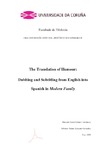Mostrar o rexistro simple do ítem
The Translation of Humour: Dubbing and Subtitling from English into Spanish in Modern Family
| dc.contributor.advisor | Lezcano, Emma | |
| dc.contributor.author | Gómez Fernández, Lucía | |
| dc.contributor.other | Universidade da Coruña. Facultade de Filoloxía | es_ES |
| dc.date.accessioned | 2022-02-11T08:49:49Z | |
| dc.date.available | 2022-02-11T08:49:49Z | |
| dc.date.issued | 2021 | |
| dc.identifier.uri | http://hdl.handle.net/2183/29769 | |
| dc.description.abstract | [Abstract] This end-of-degree project analyses a collection of episodes ofthe American sitcomModern Familyfocusing on the translation of humourfrom English to Spanish. The main purpose of this paper is to compile and classify the most relevant humorous instances, specificallylinguistic elements, paralinguistic elements, visual elements and cultural elements,as well as thepreferredsubtitling and dubbing strategies throughout the data collectedand analysed. Due to thelargenumberof examples, this work concentrates on the most significant ones while the rest have been listedin the Appendix, where they are classifiedby the already mentioned humorous elements as well as by a fifth category called compound jokes. The methodology used ischieflydivided into three procedures. Firstly, all the selectedjokes areclassified by humorous elements. Secondly, the subbed versionis analysedfollowing a taxonomy so as to decide what type of strategy the translator used when renderingthe source text. Finally, the dubbed versionis examined following an already existingproposalin order to determine howverbal humour on screenis translated.Throughout the analysis and classification of the humorous instances, this study concludes thatrendering quality in this particularseries is quite high both in the subbed and dubbed versionsdespite the huge presence of idiomatic expressions, wordplay, rhymes,and cultural references. Additionally, it is confirmedthat visual humorous elements are the most challenging jokes. Also, there is not a significant evolution of humour between years, but an evolution in the character’s lifestyle.Furthermore, the main three theories (incongruity, hostility, and release) that would constitute the essence of humour are present in the sitcom as expected. All in all, the present study contributes toshow that translators need an enormous capacity for creativity and a great command of both languages in order to provide an accurate translation. Lastly, this papercould undoubtedlyinstigate the interest in conducting further investigationon the subject. | es_ES |
| dc.language.iso | eng | es_ES |
| dc.rights | Os titulares dos dereitos de propiedade intelectual autorizan a visualización do contido deste traballo a través de Internet, así como a súa reproducción, gravación en soporte informático ou impresión para o seu uso privado e/ou con fins de estudo e de investigación. En nengún caso se permite o uso lucrativo deste documento. Estos dereitos afectan tanto ó resumo do traballo como o seu contido Los titulares de los derechos de propiedad intelectual autorizan la visualización del contenido de este trabajo a través de Internet, así como su repoducción, grabación en soporte informático o impresión para su uso privado o con fines de investigación. En ningún caso se permite el uso lucrativo de este documento. Estos derechos afectan tanto al resumen del trabajo como a su contenido | es_ES |
| dc.subject | Subtitling | es_ES |
| dc.subject | Dubling | es_ES |
| dc.subject | English | es_ES |
| dc.subject | Spanish | es_ES |
| dc.subject | Translation | es_ES |
| dc.subject | Humorous elements | es_ES |
| dc.subject | Sitcom | es_ES |
| dc.subject | Jokes | es_ES |
| dc.subject | Humour | es_ES |
| dc.subject | Modern Family. | es_ES |
| dc.title | The Translation of Humour: Dubbing and Subtitling from English into Spanish in Modern Family | es_ES |
| dc.type | info:eu-repo/semantics/bachelorThesis | es_ES |
| dc.rights.access | info:eu-repo/semantics/openAccess | es_ES |
| dc.description.traballos | Traballo fin de grao (UDC.FIL). Inglés: estudios lingüísticos y literarios. Curso 2020/2021 | es_ES |






